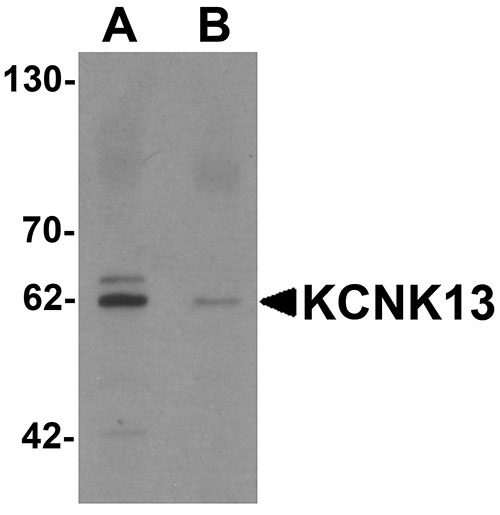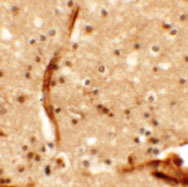KCNK13 Antibody
- SPECIFICATION
- CITATIONS
- PROTOCOLS
- BACKGROUND

Application
| WB, IHC-P, IF, E |
|---|---|
| Primary Accession | Q9HB14 |
| Other Accession | NP_071337, 16306555 |
| Reactivity | Human, Mouse, Rat |
| Host | Rabbit |
| Clonality | Polyclonal |
| Isotype | IgG |
| Calculated MW | 45391 Da |
| Application Notes | KCNK13 antibody can be used for detection of KCNK13 by Western blot at 0.5 µg/mL. Antibody can also be used for immunohistochemistry starting at 5 µg/mL. For immunofluorescence start at 20 µg/mL. |
| Gene ID | 56659 |
|---|---|
| Target/Specificity | KCNK13; KCNK13 antibody is predicted to not cross-react with other KCNK protein family members. |
| Reconstitution & Storage | KCNK13 antibody can be stored at 4℃ for three months and -20℃, stable for up to one year. As with all antibodies care should be taken to avoid repeated freeze thaw cycles. Antibodies should not be exposed to prolonged high temperatures. |
| Precautions | KCNK13 Antibody is for research use only and not for use in diagnostic or therapeutic procedures. |
| Name | KCNK13 |
|---|---|
| Function | Potassium channel displaying weak inward rectification in symmetrical K(+) solution. |
| Cellular Location | Membrane; Multi-pass membrane protein |

Thousands of laboratories across the world have published research that depended on the performance of antibodies from Abcepta to advance their research. Check out links to articles that cite our products in major peer-reviewed journals, organized by research category.
info@abcepta.com, and receive a free "I Love Antibodies" mug.
Provided below are standard protocols that you may find useful for product applications.
Background
KCNK13 Antibody: The closely related proteins KCNK13 and KCNK12 (also known as THIK1 and 2) are the first two members of a novel two pore-forming P domains K+ channels subfamily. The pore loop domain, a highly conserved region common to all potassium channels, is involved in determining potassium ion selectivity. Members of this family are all characterized by four transmembrane domains and may function to help influence the resting membrane potential of cells. KCNK13 is expressed mainly in the brain, but is also observed in kidneys. KCNK13 has been suggested to be a candidate for the Cs+-permeable K+ channel activated by GABA(B) receptors.
References
Rajan S, Wischmeyer E, Karschin C, et al. THIK-1 and THIK-2, a novel subfamily of tandem pore domain K+ channels. J. Biol. Chem. 2001; 276:7302-11.
Jezzini SH and Moroz LL. Identification and distribution of a twopore domain potassium channel in the CNS of Aplysia californica. Brain Res. Mol. Brain Res. 2004; 127:27-38.
Theilig F, Goranova I, Hirsch JR, et al. Cellular localization of THIK-1 (K(2P)13.1) and THIK-2 (K(2P)12.1) K channels in the mammalian kidney. Cell Physiol. Biochem. 2008; 21:63-74
Ishii H, Nakajo K, Yanagawa Y, et al. Identification and characterization of Cs(+)-permeable K(+) channel current in mouse cerebellar Purkinje cells in lobules 9 and 10 evoked by molecular layer stimulation. Eur. J. Neurosci. 2010; 32:736-48
If you have used an Abcepta product and would like to share how it has performed, please click on the "Submit Review" button and provide the requested information. Our staff will examine and post your review and contact you if needed.
If you have any additional inquiries please email technical services at tech@abcepta.com.













 Foundational characteristics of cancer include proliferation, angiogenesis, migration, evasion of apoptosis, and cellular immortality. Find key markers for these cellular processes and antibodies to detect them.
Foundational characteristics of cancer include proliferation, angiogenesis, migration, evasion of apoptosis, and cellular immortality. Find key markers for these cellular processes and antibodies to detect them. The SUMOplot™ Analysis Program predicts and scores sumoylation sites in your protein. SUMOylation is a post-translational modification involved in various cellular processes, such as nuclear-cytosolic transport, transcriptional regulation, apoptosis, protein stability, response to stress, and progression through the cell cycle.
The SUMOplot™ Analysis Program predicts and scores sumoylation sites in your protein. SUMOylation is a post-translational modification involved in various cellular processes, such as nuclear-cytosolic transport, transcriptional regulation, apoptosis, protein stability, response to stress, and progression through the cell cycle. The Autophagy Receptor Motif Plotter predicts and scores autophagy receptor binding sites in your protein. Identifying proteins connected to this pathway is critical to understanding the role of autophagy in physiological as well as pathological processes such as development, differentiation, neurodegenerative diseases, stress, infection, and cancer.
The Autophagy Receptor Motif Plotter predicts and scores autophagy receptor binding sites in your protein. Identifying proteins connected to this pathway is critical to understanding the role of autophagy in physiological as well as pathological processes such as development, differentiation, neurodegenerative diseases, stress, infection, and cancer.




